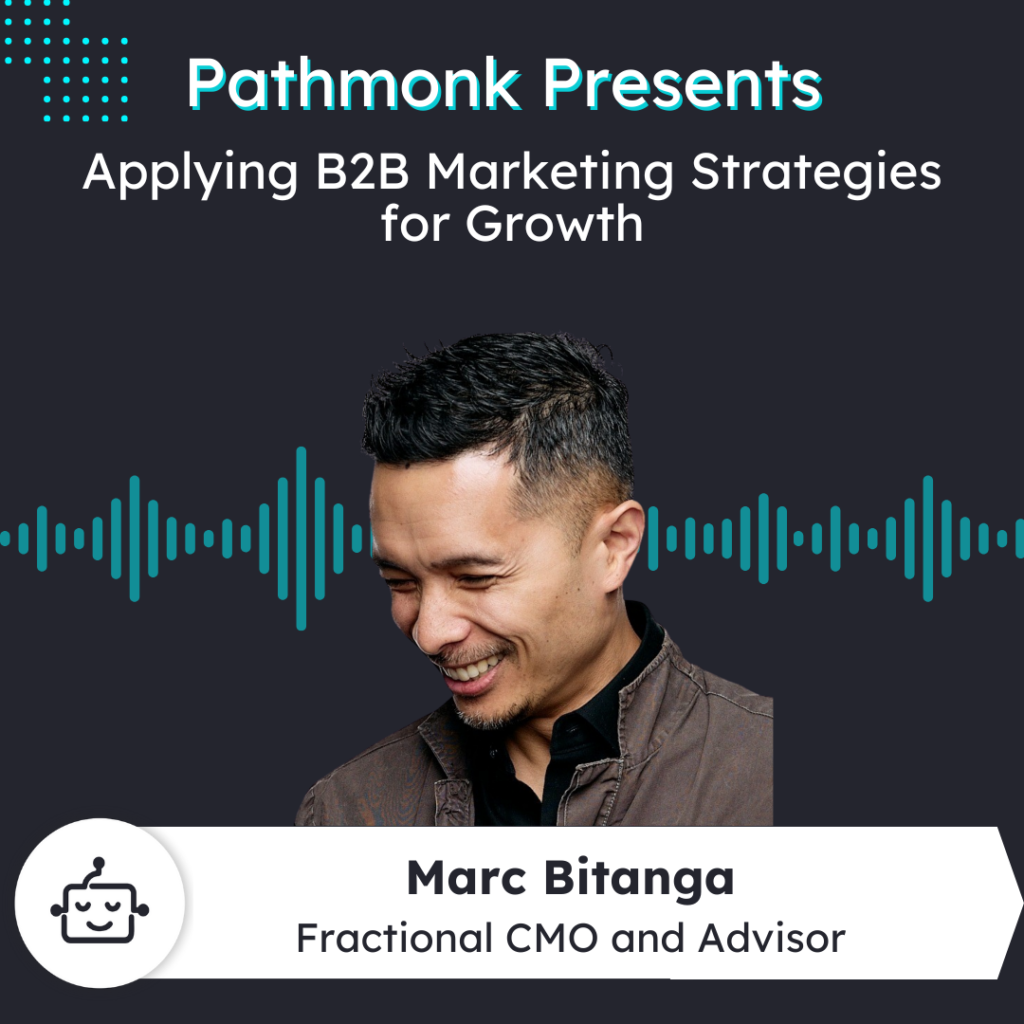
Introduction
Meet Marc Bitanga, a seasoned B2B marketing leader and fractional CMO, with experience working with top companies like SAP and Hootsuite.
Marc shares his insights on developing effective marketing strategies, building high-performing websites, and the importance of continuous testing and optimization.
He also discusses the power of qualitative insights, the role of a website as a “silent salesperson,” and practical advice for aspiring marketers.
Increase +180%
leads
demos
sales
bookings
from your website with AI
Get more conversions from your existing website traffic delivering personalized experiences.

Rick Veronese: Pathmonk is the AI for website conversions. With increasing online competition, over 98% of website visitors don’t convert. The ability to successfully show your value proposition and support visitors in the buying journey separates you from the competition online. Pathmonk qualifies and converts leads on your website by figuring out where they are in the buying journey and influencing them in key decision moments with relevant micro experiences like case studies, intro videos, and much more. Stay relevant to your visitors and increase conversions by 50%. Add Pathmonk to your website in seconds, let the artificial intelligence do all the work, and increase conversions by 50% while you keep doing marketing as usual. Come check us out on Pathmonk.com. All right, everyone. Welcome back to Pathmonk Presents. Today we are joined by Marc, a VP of marketing and fractional CMO for B2B marketing. Marc, I’ve been looking forward to this conversation, man. I think it’s going to be awesome. I just want to welcome you to the show. It’s great to have you here today. How’s it going?
Marc Bitanga: Thanks so much, Rick. Thanks for having me. I’m really looking forward to the conversation.
Rick: Likewise. So listen, I wouldn’t do it justice if I were to introduce you and give your whole bio—I think this is better coming from you. If you could give our audience a little bit of an idea of what a VP of marketing like yourself does and what’s at the heart of your day-to-day, as well as the kind of companies you work with, that would be amazing.
Marc: I’ve been in B2B marketing for the last 20 years. I’ve worked with companies like SAP, Hootsuite, Ritchie Brothers, as well as, funny enough, EA Sports, the video game company—that’s also part of my resume. I started in digital marketing before it was even called digital marketing and learned along the way. Essentially, I help my clients and brands get more out of their B2B marketing, generate more leads, drive engagement, and increase revenue.
Rick: Okay. That sounds pretty sweet. We’ve got plenty of CMOs and SaaS founders in our audience, knowing that you’ve worked with these kinds of companies. Maybe there’s something coming on the horizon for yourself. So that’s great. I just want to know a little bit about what type of businesses you enjoy working with the most and what kind of clients you feel you’re able to serve the best with your skills.
Marc: That’s a great question. I tend to find myself working with B2B SaaS companies, typically around Series A all the way to Series C. Usually, it’s during either the growth phase of the company or the scale phase. Growth means firming up and establishing their marketing engine, so to speak. Scale means operationalizing it and 10x-ing growth, whether it’s expanding globally or entering new markets. These are the types of companies I enjoy working with. I think it’s a great opportunity—not just from a fractional perspective but even as a marketing leader—to have a seat at the table. I typically work directly with CEOs and collaborate closely with VPs of marketing. I also often work alongside product teams on their product launches.
Rick: Okay, so it really spans across different teams, and I’m sure that all the needs and even the messaging will change based on who you’re speaking to, right?
Marc: Oh, absolutely.
Rick: I’m curious, if you were to summarize what you do, would you say there’s a core problem that you help these companies and executives solve specifically? Is there anything they can expect when they come to you?
Marc: I think the thing they’re looking for is a plan that gives leadership teams the confidence that when they put one dollar in, they’ll get three, five, or even ten dollars out. Essentially, it’s about establishing a marketing strategy that produces those confident outcomes. When you’re working with a startup, the goal as a go-to-market team is to build one solid concrete pillar. But often, it starts as a bunch of Jenga blocks. You’re tackling problems like operations, building the right team, experimenting with tactics, and optimizing—all of this comes together to create that predictable outcome.
CEOs and founders typically come to me for one of three scenarios:
- “We’re scratching the surface of marketing. We know we need to invest more—can you help us establish it?”
- “We’re investing in marketing, but we’re not seeing the returns we expect.”
- “Our growth has plateaued. We’ve tried everything and don’t know where to go from here.”
Ultimately, it comes down to building a marketing strategy that delivers measurable results—where the CFO is happy to hand over a dollar, knowing it will come back multiplied.
Rick: Okay, so it’s different problems for different stages, depending on where they are in their journey. Say I’m a CEO and I’m plateauing. I want to grow our marketing and get more leads. How would I find out about your services? How do I know about you and your way of doing marketing?
Marc: That’s a great question. The main way people find me is through LinkedIn. I’ve been writing on LinkedIn for years, sharing my thoughts and opinions on B2B marketing. That’s one key way CEOs and founders discover me. Another is through meetups where I’m invited to speak or mentor founders. For example, I’ve worked with New Ventures BC, an incubator here in British Columbia, Canada. Lastly, my network plays a significant role. If you combine all of these, people typically find me because of content—whether it’s a speaking engagement, a blog post, or, most recently, my newsletter, Squeeze the Funnel. It’s a raw, authentic take on B2B marketing that I send out weekly to subscribers.
Rick: That’s awesome. I love the name, by the way. Squeeze the Funnel sticks with you—you know exactly what you’re getting into without even seeing it. Great job there. Is there any story behind the name, or was it just an epiphany moment?
Marc: Oh, I had a number of horrible names, to be honest. It was one of those lightbulb moments. I quickly checked if the domain was available, and luckily it was. No deep analysis—just one of those rare moments of inspiration.
Rick: Fair enough. I’d love to know—since our audience includes founders, business owners, and marketers—what you think is the role of a website in attracting leads. What makes an ideal website, and what are the common areas where websites could improve?
Marc: A website is your silent salesperson. It’s the non-threatening, non-intimidating way for people to learn about your company without talking to someone. Recent stats show that millennials and Gen Z prefer to do their own research rather than talk to salespeople. Your website needs to cater to this behavior and serve as a critical part of the due diligence process.
The best websites I’ve seen excel in a few areas:
- Messaging and positioning: Be straightforward about what you do and who you do it for. Too often, websites rely on clever headlines, but clear, direct messaging wins every time.
- Social proof: Showcase testimonials, case studies, and logos. Trust is a huge factor, and your website should help build it.
- Calls-to-action (CTAs): Have clear, visible CTAs that guide visitors to the next step, whether it’s booking a demo or downloading a lead magnet.
Too often, websites are designed by teams more focused on aesthetics than marketing. But a website’s primary job is to convert traffic, and that requires substance over flash.
Rick: Great points. Let’s talk about tools for a second. What are some tools you’d recommend for marketers? These could be related to conversion rate optimization or anything you’ve used over the years that’s been a game changer.
Marc: Two tools come to mind. First, Unbounce. It’s fantastic for lightweight A/B testing without needing to rely on tech teams. You can experiment with different messaging, layouts, and CTAs quickly and see what works. Second, UserTesting.com. It’s invaluable for gathering qualitative insights. Quantitative data tells you what’s happening, but qualitative insights tell you why. I’ve used UserTesting to get raw feedback on landing pages, and it’s been eye-opening. For example, we once had a landing page with tons of value props, but users said it looked like too much work for them. Without qualitative feedback, we’d never have caught that.
Rick: I love that you mentioned both tools. Sometimes, less really is more. Okay, shifting gears a bit—let’s talk about you as a leader. What does a typical day look like for you? What are your key tasks?
Marc: Once the marketing strategy is in place, it’s all about execution. My day focuses on three things:
- Prioritization and unblocking: I start each day with a standup to see what everyone is working on and remove roadblocks.
- Campaign tracking: I dive into SEO performance, paid media metrics, and campaign analytics to ensure everything is on track.
- Agile execution: I run two-week sprints for everything. It’s a great tool for prioritizing, communicating, and even negotiating with leadership when new tasks come up.
Overall, it’s about ensuring the team executes efficiently and stays aligned with company goals.
Rick: I love the idea of using sprints for marketing—it keeps things organized and adaptable. Okay, we’re nearing the end of the interview, and I have some rapid-fire questions for you. Short, quick answers only—are you ready?
Marc: Let’s do it.
Rick: What’s the last book you read?
Marc: The Ultimate Sales Letter by Dan Kennedy. It’s a fantastic resource for direct response copywriting.
Rick: What’s one thing most companies you work with are focused on?
Marc: Customer acquisition and feeding the pipeline.
Rick: If there were no boundaries in technology, what’s one thing you’d want to fix as a marketing leader?
Marc: I’d want a tool that tracks the entire buyer journey across all touchpoints—from websites to conversations.
Rick: What’s one repetitive task you’d love to automate?
Marc: Insight gathering from data. Forget reports—just give me actionable insights.
Rick: What’s one piece of advice you’d give your younger self as a marketer?
Marc: Start marketing. Don’t overthink it—launch a newsletter, build a Shopify store, or try out campaigns. You learn by doing.
Rick: Great advice. Finally, if someone forgets everything about this interview, what’s the one thing they should remember about your work?
Marc: Check out Squeeze the Funnel at squeezethefunnel.com. It’s where I share raw, unfiltered insights on B2B marketing.
Rick: Perfect. Marc, thanks so much for being on the show. It’s been a pleasure.
Marc: Thanks, Rick. It’s been great.
Rick: Take care, Marc.
Marc: You too.











